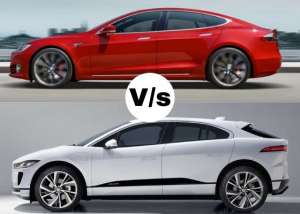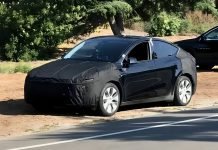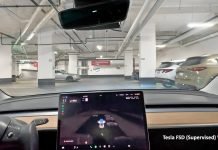Tesla has dominated the premium EV space for almost a decade with the likes of Model S. Tesla has taken the automotive world by a storm and has created such an impact that even the biggest players in the industry are having a tough time to match up to the competition. Although many brands have been offering entry-level EV’s that do decently well but to match Tesla’s cadre in terms of performance and range as well as the premium feel has been a tough job for all.
After all these years of leading the EV market, Tesla has finally seen a worthy opponent in the name of Jaguar I Pace. At last, a praiseworthy rival from Europe has risen to challenge the torchbearer of the USA.
Tesla Model S vs Jaguar I-Pace Comparison

Ownership
Jaguar I-Pace
The Jaguar I Pace Offers a distinctive five year/200,000km warranty with roadside assistance with an additional free servicing for the first five years. A standalone eight year/160,000km warranty for the battery is given to buyers gives too much assurance. Jaguar assures that Jaguar service centers are equipped with an I-Pace specialist giving quality service to its customers.
Tesla Model S
The Model S offers a four-year/80,000km warranty with roadside assist applying for the four year warranty period. It provides a parallel eight-year/unlimited kilometer warranty for the battery and drive units. Two maintenance plans are on offer, “The three-year plan that costs $2100” and “The four-year plan costing $3175” which makes paying for these services individually over the same period to cost $2300 and $3425 respectively. The service plan includes a wheel alignment if needed so this can be a peace of mind for Tesla Owners. The first 400kW/h of recharging is free using Tesla’s supercharger network.
Safety
Jaguar I-Pace
The I Pace comes equipped with six airbags. Advanced city AEB capability of applying full braking force at speeds up to 50km/h and ‘collision mitigation’ up to 80km/h is on offer. I Pace offers traffic sign recognition and adaptive speed limiter as a part of its Safety package which also includes a driver condition monitor. Assist features like a reversing camera and 360-degree parking sensors make things easier. Superior features like lane keep assist and park assist are on offer. The recently added, clear exit monitor alerts the passengers of oncoming traffic before they open their door. An ‘Audible Vehicle Alert System’ (AVAS) to evade the near-silence of the electric car in motion, in an attempt to warn other road users to stay clear of the vehicle is approaching at speeds up to 20km/h. Another innovative contingency is the active bonnet with external airbags to reduce impacts with pedestrians. The highway AEB along with adaptive cruise control extends collision mitigation up to 160km/h, and blind-spot assist. Steering assist comes integrated with the adaptive cruise control, which provides semi-autonomous driving and a 360-degree camera system. All options of the I Pace have just been awarded a maximum five-star safety rating from ANCAP, according to 2018 criteria.
Tesla Model S
Tesla offers as standard a six airbag setup. Advanced safety features like ABS, stability and traction controls, three ISOFIX points, rollover sensors, emergency power disconnect come equipped. Additionally, upon receiving software update full AEB, self-driving and an ultra-clever active cruise will become active in the vehicle. The active cruise will enable the vehicle to change lanes and overtake if the car ahead falls below the set speed of the Tesla. The Model S scored the first highest ever five ANCAP stars, in April 2015 via the sharing arrangement with EuroNCAP.
Driving Experience
Jaguar I-Pace
The driving experience of a Jaguar I Pace comes with an incredibly reflexive accelerator pedal, the I Pace delivers better acceleration than most combustion-engined vehicles. I-Pace’s boasts a 4.8s margin to reach 100km/h from a stand-still, which is as quick as plenty of modern supercharged V8 Jags. The panoramic glass roof could be felt hot to touch but the clever UV-resistant coating still managed to keep the cabin cool. Dual stage-brake regeneration is also available. The I-Pace offers such subtle braking that it doesn’t feel like that the car is self-braking. The other mode when set to max, lets the driver hardly use brakes at city speeds maximizing the “regeneration power” and therefore your range between charges.
The wheelbase that is just under 3meters allows it to be nimble in changing directions although it is taller and a 150 kg heavier than the high spec BMW 5 Series. Nudge that accelerator pedal, the car will zip to beyond the legal limit in a snap of a finger. The I-Pace boasts of good sound insulation effectively amplifying wind and road noise. The surprisingly impressive exhaust noise, which pumps a restrained fake engine note through the speakers intensifies with Dynamic drive mode selected.
Tesla Model S
Since the beginning, the silence of the electric motor is soothing even now when more than one motors power the car. The air suspension is firm but comfortable ride and despite the 21-inch rims and very low profile tyres it manages to maintain a contented feel. In terms of acceleration, much improvement has been seen over the years in the way it drives. The steering is has become more responsive especially in Sport mode, but not much feedback is transmitted through the air suspension, taking a while to build confidence in the chassis. Chassis and NVH (noise, vibration and harshness) squashers, do a decent job owing to the absence of the engine noise. The acceleration is effortlessly quick. The response is instant when the throttle is mashed. It’s fun as a passenger as well. The acceleration is conveyed with a truckload more G-force.
Fuel consumption
Jaguar I-Pace
I-Pace’s official consumption rate of 21.2kWh/100km (WLTP) may equate to a lot less than its official range claim of 470km (WLTP) on a single charge. The Electric vehicle holds a large 90kWh battery system at its disposal. Specs state I-Pace takes around 43 hours to charge fully at a charging rate of 11km/hour. Jaguar suggests that an overnight charge will suffice the daily commuting needs for the average motorist. Recharge time can be bumped up to 35km of range per hour with a Jet Charge wall box installed, dropping the total charge time down to 13 hours. Installing a basic Jet Charge wall box is an additional cost of a minimum of $2280. Charging at public charge stations can be done via a $425 charge cable. This cable enables compatibility with Type 2 AC and Type 2 CCS combo DC charge points. Jaguar declared that there are around sufficient, including faster-charging options as well. The existing fastest charging scenario would be via a 350kW ultra-rapid charger promising a 0-80 percent charge in around 40 minutes which is very similar to supercharging a Tesla.
Tesla Model S
Owing to the new rules for Tesla Superchargers, it is now not as cheap to own and run a Tesla as it was before January 2017, but Home Charging will probably be cheaper than using Tesla’s chargers. There are companies that offer $1 per day charging for electric cars. Charging a Tesla up to 100 percent rather than the Tesla recommended 80 percent state, the trickle charge manages to squeeze just over 400km on the charge.
Engine & transmission
Jaguar I-Pace
In the I-Pace’s case, there are two identical output producing motors are placed at opposing axles, driving each axle through dedicated single-speed transmissions. Both motors are of the permanent magnet type. These are rated at 147kW/348Nm each, and the combined system outputs are a 294kW/696Nm, regardless of the trim level. The dual-motor setup enables the I-Pace to achieve a 50/50 weight distribution and facilitates a full-time all-wheel drive without the usual mechanical connection needed to link the two axles.
Tesla Model S
The Model S propels with two electric motors fed by a huge battery pack which triples as the bulk of the chassis and a super-strong crash structure. The combined power output is 568kW is on offer. Torque is quoted at 1000Nm. Claimed 0-100km/h time is an asphalt tearing 2.7 seconds.
Price and features
Jaguar I-Pace
The line-up is available into S, SE and HSE trim levels with tag pricing staggered at $119,000, $130,200 and $140,800 respectively. The first year of manufacture will be topped by the HSE-based First Edition trim for $159,700, with a number of optional features fitted as standard. Key S-trim features comprise an 8-way power adjustment in the front, ‘Luxtec’ faux-leather seat trim. The infotainment system includes 10-inch multimedia and 12.3-inch driver instrument displays, Apple CarPlay and Android Auto connectivity, Meridian audio system. for cabin comforts and ease of use a Dual-zone climate, Proximity keys, LED head and tail-lights and Style 1022 18-inch alloys are available.
The First Edition scores the full extended leather package and First Edition sill plates. Warranty-length subscription is applied to the ‘InControl App Remote’ smartphone app, which allows remote monitoring of the vehicle’s status and the ability to pre-condition the cabin temperature before you arrive at the car. The SE-trim adds Leather seat trim with 10-way power adjustment, memory settings up the front seats. Other features like ‘Premium LED’ headlights, Power tailgate, Auto-dimming folding door mirrors, ‘Style 6007’ 20-inch alloys on the outside. on the inside to assist the driver a ‘Driver Assist Pack’, Steering assist with the adaptive cruise control enabling semi-autonomousity, A 360-degree camera system are available. The S’s safety arsenal, includes a ‘Drive Pack’ which is essentially an adaptive cruise control with stop and go, high-speed AEB and blind-spot assist. The HSE fetches Premium ‘Windsor’ leather seats, Heated and ventilated seats, 18-way adjustable memory fronts and heated rear seats, Matrix LED headlights, Auto powered tailgate, Style 6007 20-inch alloys.
Beyond the HSE, the First Edition includes a fixed panoramic glass roof that costs around $3380,Tinted windows for a price of $845, Gloss black window surrounds ($598), Front fog lights for $403 and 20-inch ‘Style 5070’ alloys ($390 on HSE) on the exterior. Features that up the premium feel on the inside of the car include options such as First Edition sill plates, the complete extended leather package includes dash and more ($2763), four-zone climate control ($1820), Alcantara headlining ($2496), First Edition-specific wood trim, the ‘Cold Climate Pack’ ($1060) of heated steering wheel, heated windscreen and windscreen washers, variable ambient lighting ($507), head-up display ($1040), waterproof activity key ($910), carpet mats ($299) and DAB+ digital radio ($520). Under the skin the First Edition includes active airbag suspension ($2002), ‘Adaptive Dynamics’ with configurable drive modes ($2405), ‘Adaptive Surface Response’ ($2002). These benefits are added for $18,900 premium over the HSE, are worth $23,440 as options.
Tesla Model S
Tesla in its roots is a technology company, it won’t be wrong if it is said that they make extremely good batteries that are offered with a car around it, so the features and options reflect that. It’s more of a gadget-laden five-door hatch powered exclusively by electricity loaded with things that drink the battery juices fast enough.
Standard features include Seven-speaker stereo, that can be an optional 11-speaker audio upgrade with neodymium magnets for $3800. Other upgrades include leather-like trim, 19-inch alloys, optional 21-inch grey ‘Turbine’ wheels ($6800), reversing camera, 17.0-inch touchscreen, keyless entry and start, forward collision warning, digital dashboard, electric front seats, sat-nav, auto LED headlights, auto wipers, internet connectivity via included SIM card, power mirrors and windows and air suspension. Optional features include panoramic roof ($2300), multi-coat pearl paint (white, $2300) and carbon-fiber interior trim bits for $1500, as well as a carbon lip spoiler for another $1500. The ‘Subzero Weather Package’ includes seat heaters, heated steering wheel, wiper blade defrosters and washer nozzle heaters.
An onboard high-power charger that speeds up charging with the ‘Tesla Wall Connector’, is offered at $2300. Optional ‘Enhanced Autopilot’ ($7600) capable of highway running, is equipped with four cameras and 12 ultrasonic sensors around the car, and upgraded processing power to run it all. ‘Full Self-Driving Capability’ ($4600) feature is to be used around town. Tesla is equipped with 8 cameras and more sensors.
A ‘Premium Upgrades’ package offers the overkill of a ‘Bioweapon Defense Mode’. What is does is that this system knocks out 99.97 percent of exhaust particulates and other contaminants while using two activated carbon air filters for other nasties like NO2 and hydrocarbon exhaust fumes. Other features include LED turning lights and fog lights, Real leather on the armrests, Steering wheel and lower dashboard, Nappa leather and Alcantara on the dashboard, Soft LED interior lighting, Power tailgate, and backlit door handles for $5300.
Practicality
Jaguar I-Pace
The all-new platform and body stabilizes battery underfloor and four-seat arrangement very well with out-and-out aerodynamics. With five seat belts, the cabin is narrower at the rear comfortably seating only two adults, which will no doubt meet most expectations. Cars fitted with the optional fixed panoramic glass roof expands the headroom by an extra few centimeters. Ample headroom in the back seat and plenty of legroom behind driving position. The back seat has ISOFIX child seat mounts in the outward positions. The lack of transmission tunnel in the floor gave space for useful storage cubby under the dash’s center stack. It also has a generous 10-litres center console bin. Interior holds four USB points and three 12-volt power outlets spread throughout the cabin. The boot is a wagon-like 656 liters with 60/40 split-fold rear seats. The boot floor holds space for things like charge cables and wet items, and a bonus 27-litres front boot. A very useful, compact inflation kit under the boot floor instead of a space saver or full-size spare tyre.
Tesla Model S
The Tesla Model S has an almost completely flat floor. The two independent motors means there’s no crankshaft eating up space. The floor is thicker than a normal car, which means knees are up higher, causing numbness in bum on a long trip. The rear seats are comfortable enough. No compromise on performance even it the vehicle is completely loaded. The rising window line gives an unobstructed view. The boot is an eminently sensible 744 liters with the seats up and 1795 with the seats down. Up in the front boot is another 150 litres.
Design
Jaguar I-Pace
The Jaguar’s design houses a single electric motor on each axle. The large and heavy battery system is located along the floor of the body with the rest of the chassis comprised of aluminium. Jaguar claims that the I-Pace comes with the brand’s most torsionally rigid structure. The I-Pace achieved a slippery 0.29Cd aerodynamic drag coefficient due to its more coupe than the SUV-like roofline. The interiors are more modern-day Jaguar though, with surfaces and textures with hints of the recent E-Pace SUV. An expansive 2990mm wheelbase was given to the vehicle ditching The usually long bonnet. The taller SUV-like body allows more room for humans above the batteries.
Tesla Model S
The Tesla Model S has a slinky roofline and low-slung stance. Its cabin has enhanced even more than the exterior. The styling is it’s a cleaner design than when first launched, with a simpler, flatter snout that brings out the headlights better. The updated version 8 of the 17.0-inch portrait screen comes skewed-to-the-driver position.


















